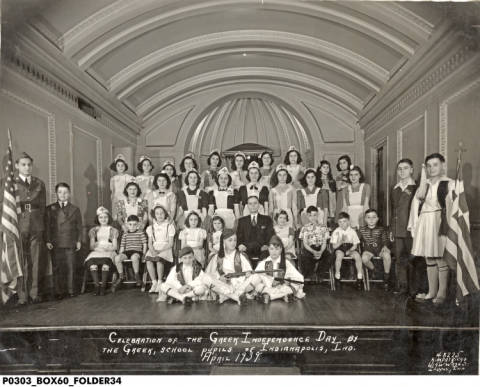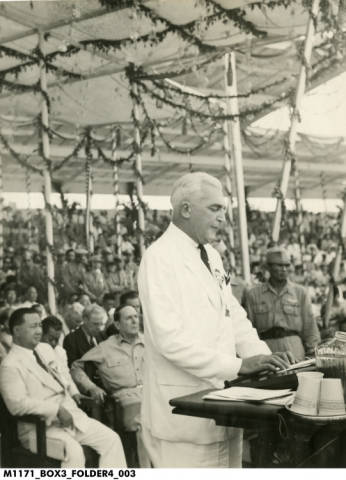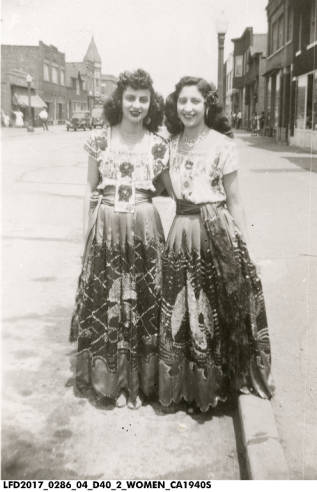
Purchase Tickets
Independence Days in America
June 30, 2020

While we typically associate Independence Day with the Fourth of July and America declaring independence from Great Britain, all over Indiana there are various Independence Day celebrations throughout the year that celebrate the independence of many different countries. Here at the Indiana Historical Society, our collections have documentation for a variety of different cultures celebrating the independence of their homelands.
On March 25th, 1821, Bishop Germanos of Patras went to the top of the Monastery of Agia Lavra and raised a flag of revolution. The fight for Greek Independence had begun. Despite some early victories on the battlefield, the Greeks suffered from severe in-fighting and the revolution was on the verge of collapse by 1827. However, European powers, including Great Britain, France and Russia were all moved by the Greek’s strong desire for independence and joined the fight. Fighting continued until 1829 when the Treaty of Edirne ended the war and established an independent Greek state. Today, Greek Independence Day is celebrated annually on March 25th with parades and celebrations of Greek costumes and dance.1

Indianapolis Recorder Collection, Indiana Historical Society
In 1898, The United States of America was in the middle of yet another war, this time fighting against the Spanish in Cuba over Spain’s colonial policies. At the same time, Emilio Aguinaldo was making arrangements with Admiral George Dewey to return to the Philippines to restart the revolution that had flamed out less than a year prior. Fighting alongside the Americans and against the Spanish, Aguinaldo officially declared Philippine Independence on June 12, 1898. By the following January, Aguinaldo had become president of this new country and started the Malolos Republic. However, the Americans made a deal with Spain that ended the Spanish-American War and included America taking control of the Philippines. On July 4, 1946, America formally granted independence to the Philippines. Former Indiana Governor and Ambassador to Philippines Paul V. McNutt was present at the celebration. Despite this, the Philippines still celebrate independence on June 12th.2

Indiana Historical Society, M1171
As the Napoleonic Wars wracked Europe, Miguel Hidalgo y Costilla started a revolt in the Mexican city of Dolores. On September 16, 1810 Hidalgo issued the “Grito de Dolores (Cry of Dolores)”, which called for the end of Spanish rule, the equality of races and the redistribution of land. While Hidalgo’s revolt ultimately did not succeed, he laid the groundwork for future rebellions that eventually led to Mexican independence in 1821. Despite several different revolts and fighting for years, September 16 is still celebrated as Mexican Independence Day. Today, celebrations for Mexican Independence happen all over the country and all over Indiana.3

Lydia Castillo, Indiana Historical Society
Across the country and across the state, Hoosiers celebrate the independence of a variety of different countries. These celebrations honor the sacrifice of different men and women and the traditions of different homelands. Most of these celebrations include parades, demonstrations of traditional dress and honoring the culture of the homeland. From Greek dances to climbing greased poles, all of these celebrations are unique. And, we can see a reflection of these celebrations in our own Independence Day celebrations. Fourth of July celebrations include competitions of strength, different costumes and parades that block streets. While we celebrate our Independence Day, we should remember that hundreds of countries also celebrate their own independence. You can learn more about these celebrations online, in our digital collections.
1 The Editors of Encyclopaedia Britannica. (n.d.) Greek Independence Day. Encyclopædia?Britannica. https://www.britannica.com/topic/Greek-Independence-Day; http://images.indianahistory.org/cdm/singleitem/collection/p0303/id/485/rec/19
2 Hernandez, C.G., Cullinane, M., and Borlaza, G.C. (2020, May 15). Philippines. Encyclopædia?Britannica. https://www.britannica.com/place/Philippines/The-19th-century#ref23716; http://images.indianahistory.org/cdm/singleitem/collection/p16797coll31/id/56/rec/3
3 Griffin, E.C., et.al. (2020, May 15). Mexico. Encyclopædia?Britannica. https://www.britannica.com/place/Mexico/Expansion-of-Spanish-rule; http://images.indianahistory.org/cdm/singleitem/collection/p16797coll38/id/420/rec/5;









